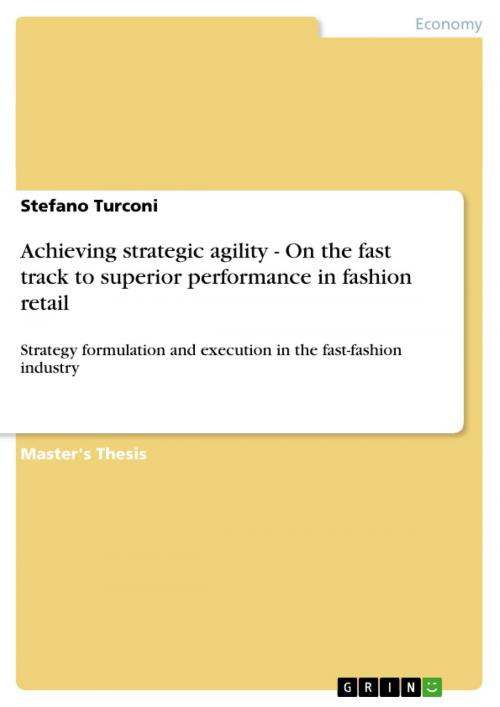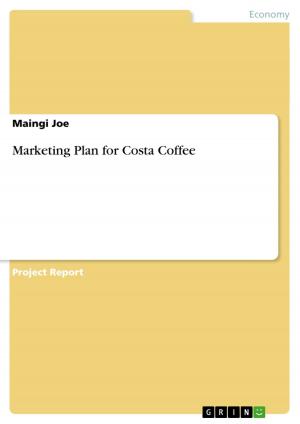Achieving strategic agility. On the fast track to superior performance in fashion retail
Strategy formulation and execution in the fast-fashion industry
Business & Finance, Management & Leadership, Management| Author: | Stefano Turconi | ISBN: | 9783640539420 |
| Publisher: | GRIN Publishing | Publication: | February 17, 2010 |
| Imprint: | GRIN Publishing | Language: | English |
| Author: | Stefano Turconi |
| ISBN: | 9783640539420 |
| Publisher: | GRIN Publishing |
| Publication: | February 17, 2010 |
| Imprint: | GRIN Publishing |
| Language: | English |
Master's Thesis from the year 2007 in the subject Business economics - Business Management, Corporate Governance, grade: A+, London Business School, language: English, abstract: Fashion retail has always been a highly competitive and fast-changing business where many chains have risen dramatically and then fallen just as quickly. Today, as many firms are struggling to compete while simultaneously managing their costs and delivering adequate returns, others are thriving in the face of shifting circumstances. In the past decade, a relatively new phenomenon called fast fashion has commanded the attention of the consumers, managers and investors. Fast fashion retail pioneers like Zara and H&M, with their super-responsive supply chains and efficient decision-making processes, are able to produce and distribute affordable high-end fashion at breakneck speeds. They relentlessly offer customers the cheap-chic products they want, where they want, avoiding any unnecessary faux pas. As a result, they enjoy higher profit margins than their competitors-an average of 16-plus percent versus a modest 7 percent for typical apparel or specialty-apparel retailers. And in European countries, where the concept began, this business represents anywhere from 5 to 18 percent of the total apparel market. An in-depth analysis of a set of fashion retailers has revealed some of the critical ingredients of success, distinguishing such factors from incidental ones. In essence, we found that what sets fast fashion companies apart from all other competitors is that they conceive strategy and its implementation as an iterative rather than a linear process. They intuitively yet consistently move through a loop, placing less emphasis on hierarchy and more on feedback, dialogue, group processes, understanding organisational complexity and dynamics, and limiting uncertainty. By moving through the iterative cycle of translating understanding into action, they are able to fashion superior strategies and performance.
Master's Thesis from the year 2007 in the subject Business economics - Business Management, Corporate Governance, grade: A+, London Business School, language: English, abstract: Fashion retail has always been a highly competitive and fast-changing business where many chains have risen dramatically and then fallen just as quickly. Today, as many firms are struggling to compete while simultaneously managing their costs and delivering adequate returns, others are thriving in the face of shifting circumstances. In the past decade, a relatively new phenomenon called fast fashion has commanded the attention of the consumers, managers and investors. Fast fashion retail pioneers like Zara and H&M, with their super-responsive supply chains and efficient decision-making processes, are able to produce and distribute affordable high-end fashion at breakneck speeds. They relentlessly offer customers the cheap-chic products they want, where they want, avoiding any unnecessary faux pas. As a result, they enjoy higher profit margins than their competitors-an average of 16-plus percent versus a modest 7 percent for typical apparel or specialty-apparel retailers. And in European countries, where the concept began, this business represents anywhere from 5 to 18 percent of the total apparel market. An in-depth analysis of a set of fashion retailers has revealed some of the critical ingredients of success, distinguishing such factors from incidental ones. In essence, we found that what sets fast fashion companies apart from all other competitors is that they conceive strategy and its implementation as an iterative rather than a linear process. They intuitively yet consistently move through a loop, placing less emphasis on hierarchy and more on feedback, dialogue, group processes, understanding organisational complexity and dynamics, and limiting uncertainty. By moving through the iterative cycle of translating understanding into action, they are able to fashion superior strategies and performance.















